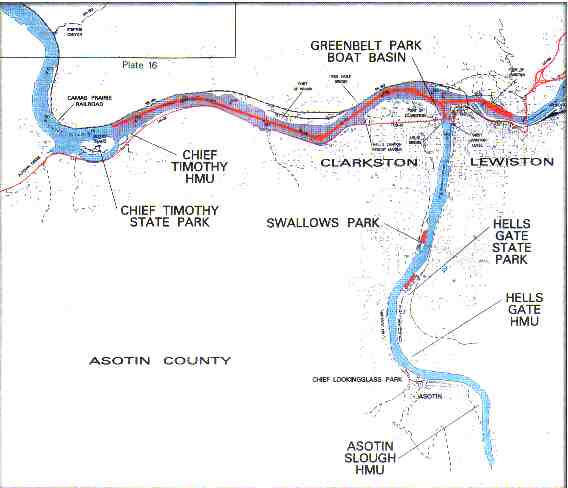forum
library
tutorial
contact

Snake River Dredging -- a 20-Year Plan
by Glen Squires
WHEAT LIFE, March 2002
|
the film forum library tutorial contact |

|
Snake River Dredging -- a 20-Year Planby Glen Squires WHEAT LIFE, March 2002 |
Maintenance Dredging with Beneficial Use of Dredged Material and a 3-Foot Levee raise is Alternative four and the one preferred by the U.S. Army Corps of Engineers to address issues related to dredging in the snake River for the next 20 years. The Corps, along with the environmental Protection Agency (EPA), evaluated the best way to fulfill the Corps' responsibilities for maintenance of the inland navigation waterway, which includes Ice Harbor, Lower Monumental, Little Goose and Lower Granite reservoirs on the Snake River, and the McNary reservoir on the Columbia River.
 The preferred alternative from the Dredged Material Management Plan and Environmental Impact Statement (DMMP/EIS) "most completely and efficiently meets the project purpose and need at the least cost, while presenting potential environmental impacts that are no greater, and often less, than other alternatives considered," according to the Corps.
The preferred alternative from the Dredged Material Management Plan and Environmental Impact Statement (DMMP/EIS) "most completely and efficiently meets the project purpose and need at the least cost, while presenting potential environmental impacts that are no greater, and often less, than other alternatives considered," according to the Corps.
The first dredging activity under the DMMP is proposed for winter 2002/03 and includes dredging the navigation channel at the confluence of the Snake and Clearwater rivers, several port facilities in Lower Granite and Little Goose reservoirs, navigation lock approach to Lower Granite and Lower Monumental Dams, along with several other areas (see attached diagram showing dredge location in red). The Corps will use in-water disposal to create fish habitat in Lower Granite reservoir as the beneficial use of dredged material. Raising the levee was found to reduce the need for dredging in the confluence area of Lower Granite reservoir and reduce flood potential. Levee construction is expected to begin after 2005.
Other uses for dredged material include potting soil, fill for use on roadway projects, and fill for non-federal lands and at the Port of Wilma. Some of these uses would require cost sharing. While the announcement of the preferred alternative is good news for river users and the region, the Corps has a lot of work to do. As a result of Endangered Species consultation with the National Marine Fisheries Service and the U.S. Wildlife Service, the Corps would be required to prepare a Biological Assessment for each dredging activity, or for up to five years of dredging activities. Likewise, depending on the outcome of coordination with state water quality agencies and the EPA, the Corps would be required to prepare a Clean Water Act evaluation for each dredging activity, or for five to 10 years of dredging.
With respect to transportation, some disruption may occur to the navigation channel on a two-year cycle during the in-water work period December 15 to March 1 in the Snake River, and December 1 and March 31 in the Columbia River. The Corps suggests that a beneficial use of dredged material may be to use material to form a roadway connection on the north shore of the Lower Granite pool linking State Route (SR) 193 at Wawawai to SR 194, a distance of three miles. The environmental effects of the dredging alternative are listed in Table 1.
| Aquatic Resources | Indirect, minor, short-term on food source for aquatic species; no long-term effect anticipated. Potential effects from creation of shallow-water fish habitat and/or beneficial use that may restore habitat. |
| Terrestial Resources | Minor, short-term negative effects through disruption of habitat from levee raise; potential long-term postive effects from beneficial use of dredged material to create upland habitat. |
| Endangered Species | Dredging timing minimizes impact; minor impact to bull trout; beneficial use from habitat creation. Short-term effect on bald eagle; minor impacts on plants anticipated. |
| Cultural Resources | Known submerged cultural properties avoided to extent practicable. Potential effects of beneficial uses evaluated as proposals are developed. |
| Socioeconomics | Direct, short and long-term positive effects of water quality due to turbidity; no direct effect on wetlands; minor indirect effects with levee raise. |
| Transportation | Direct, short-term effect on roadways from levee/road raises construction. Potential positive effect if material is used for transportation projects. |
| Geology and Soils | Potential short-term effects to soils due to construction activities. |
| Water Quality / Water Resources | Direct, minor, short-term effects to water quality due to turbidity; no direct effect on wetlands; miinor indirect effects with levee raise. |
| Hazardous, Toxic, and Radioactive Waste | No effects anticipated; sediments will be tested for contamination. |
| Air Quality | Direct, minor, short-term effects to local air quality due to dredging, disposal, and construction equipment operation. |
| Noise | Direct, minor, short-term effects to noise from dredging and disposal equipment operation. |
| Aesthetics | Direct, minor, short-term effects from dredging and disposal; long-term, minor impacts from levee raise. |
| Native American Tibal Communities | Potential positive effects on salmonid fish from creation of shallow-water fish habitat. |
| Cumulative Effects | Potential positive effects on salmonid fish from creation of shallow-water fish habitat. |
| Source: U.S. Army Corps of Engineers, Draft DMMP/EIS |
learn more on topics covered in the film
see the video
read the script
learn the songs
discussion forum
